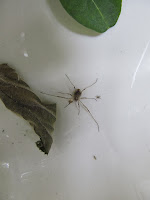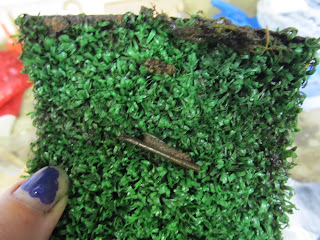Hello!
Last Friday I took part in a free training course offered by
The Conservation Volunteers (TCV) at their office in Stirling which was handy as it's not far on the train.
The workshop offered a general introduction to invertebrates and the groups and orders within. I learned there are 26 species of
Harvestmen in the UK, 17 of which are present in Scotland - who knew! I also discovered that species which undergo an incomplete metamorphosis from larvae to adult (that is to say they go, egg - nymph - moultmoultmoultmoult - adult) are Hemimetabolous, which includes cockroaches, dragonflies, earwigs and the like. Those which do a full on complete metamorphosis (egg - larvae - pupae- adult), for instance ladybirds and butterflies, are Holometabolous.
After lunch we moved on to actual survey techniques which you'll need if you want to study these wonderful creatures at close range. The various types of moth traps were explained, and which ones were best for portability and effectiveness. Next were pitfall traps, where you dig a small container like a plastic cup into the ground with the lip flush with the ground level, leave it overnight and see what unsuspecting beasties have fallen in the next day. Also water traps which are brightly coloured bowls filled with some water with a dash of washing up liquid to break the surface tension, unfortunately these result in a watery death for the insects that are attracted to them. Apparently wasps are attracted to white most of all, so bear that in mine when you're picnicking next summer. Simple methods like beating trays, where you have a large white sheet stretched over a wooden frame and then hold it under bushes while you shake the foliage to see what falls out, and sweep netting which involves vigorously swishing a sturdy fabric net to and fro among plantlife, are basic but very effective ways of surveying.
We also discussed walking transects and the best times of year to carrying them out (May to September if anyone is interested) and then turned to aquatic techniques including kick sampling (disturbing the sediment and then sweeping your net to catch anything) and water sweeping (similar to terrestrial sweep netting).
After some pointers on the best places to submit any data you collect (irecord -
www.brc.ac.uk.irecord) we headed out to the TCV garden for a pond sweep. I've done a few kick samples and pond sweeps myself however I was surprised at the density and diversity of this one! Check out all the goodies - Newt larvae, ramshorn snails, great pond snail, lesser and greater water boatmen, non-biting midge larvae, caddisfly, hoglouse, waterfleas and tons of tiny zooplankton.
 |
| Newt nymph and Great Pond Snail |
 |
| Caddisfly larvae (centre) and Lesser Water Boatman |
 |
| Ramshorn snail |
 |
| Backswimmer (Greater Water Boatman) |
We then had a look at a couple of pitfall traps which had been put out the night before and were bustling with rove and ground beetles. A quick look around the rest of the garden found 7-spot ladybirds huddling together in dried out knapweed flower heads.
We then walked along near Stirling castle and caught a few different types of hoverflies, including the
Marmalade and the
Sunfly, as well as several types of tree and frog hoppers, money spiders, common flower bugs, woodlice, earwigs and millipedes. Certainly a fruitful day for inverts and free too!
 |
| Tasty brambles |
 | | | | |
|
| I bagged this gorgeous orb weaver spider..and put it back obviously |
|
|
|
|


























































